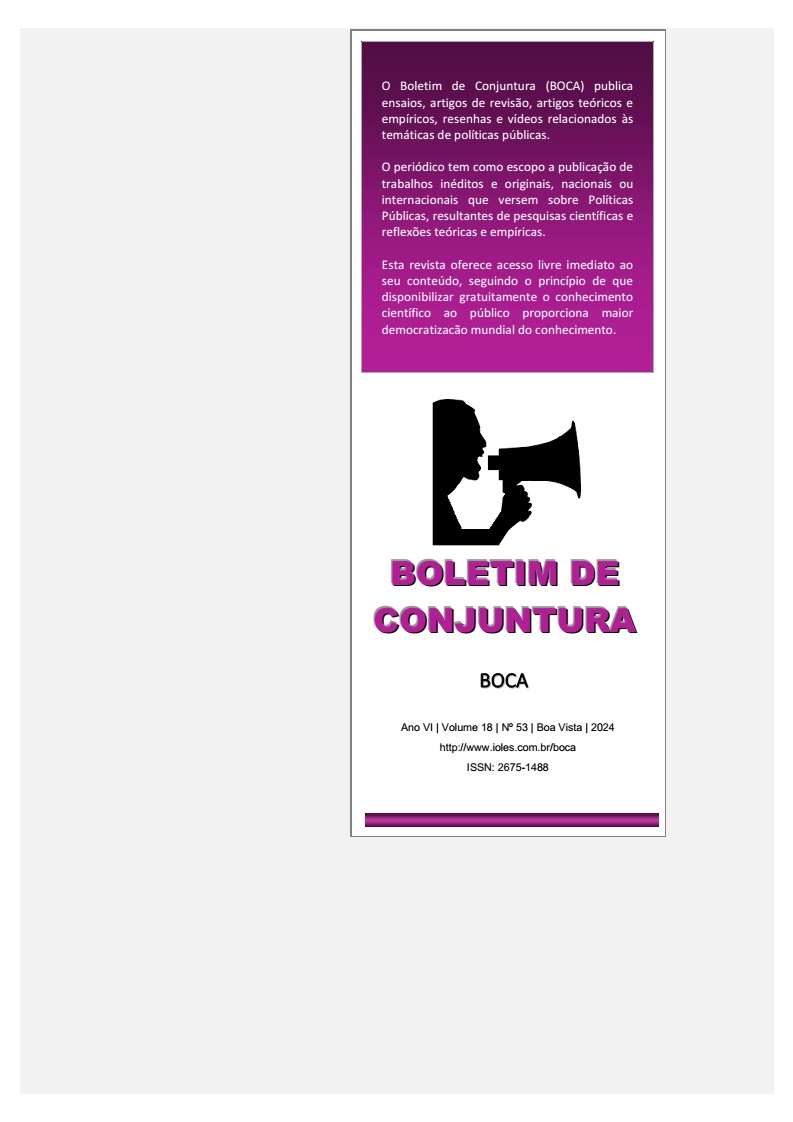TELEJOURNALISM AND TRANSPOSITION OF THE SÃO FRANCISCO RIVER: A SOCIO-ENVIRONMENTAL MYTHOCRITICISM
Main Article Content
Abstract
Over the years, television journalism has played a significant role in shaping opinions on environmental conservation policies. In addition to providing information of public interest, television news also incorporates symbolic elements that shape our values and beliefs. Thus, this article aims to understand how this media product is influenced by myths and symbols and how these reflect our socio-environmental practices. The study, qualitative, descriptive, and documentary in nature, analyzes two television reports on the diversion of the São Francisco River's waters, one from 2007 and another from 2017. The approach method was inductive, involving the formulation of general conclusions based on specific observations. As a technical procedure, we transcribed the texts of the reports and then, through Mythocriticism, a methodology developed in the studies of the Anthropology of the Imaginary, we interpreted and identified the Mythemes, Mythologems, and the Canonical Narrative present in the way the news is produced. As a result of the study, we reveal the influence of the Greek myth of Prometheus, the indigenous myth of Sumé, and the Yoruba myth of Exu in the themes concerning human-nature interaction, illustrating the complexity of approaches related to progress and environmental conservation. In this way, this interdisciplinary study concludes that the complex interactions between society and nature can provide reflections on the role of culture and symbols in promoting ecological actions.
Article Details

This work is licensed under a Creative Commons Attribution 4.0 International License.
Copyright (c). Conjuncture Bulletin (BOCA)
This work is licensed under a Creative Commons Attribution 4.0 International License.
References
ABRAM, D. The spell of the sensuous: Perception and language in a more-than-human world. London: Vintage, 2012.
BACHELARD, G. A poética do devaneio. Rio de Janeiro: Editora Martins Fontes, 2009.
BACON, F. Novum organum. Paris: PUF, 2010.
BERGER, P.; LUCKMANN, T. La construcción social de la realidad. Buenos Aires: Amorrortu Editores, 2012.
CAVALCANTI, A. P.; CAVALCANTI, C. A. O que é o imaginário? Olhar biopsicossocial da obra transdisciplinar de Gilbert Durant. João Pessoa: Editora da UFPB, 2015.
DARDEL, E. O Homem e a Terra: Natureza da realidade geográfica. São Paulo: Editora Perspectiva, 2011.
DAVID, R. S. “Sem folha não há orixá: Aproximações entre a umbanda e a educação ambiental”. Boletim de Conjuntura (BOCA), vol. 12, n. 34, 2022.
DUNK, T. “Talking about trees: Environment and society in forest workers’ culture”. Canadian Review of Sociology and Anthropology, vol. 31, n. 1, 1994.
DURAND, G. “Sobre a exploração do imaginário, seu vocabulário, métodos e aplicações transdisciplinares: mito, análise e mitocrítica”. Revista da Faculdade de Educação, vol. 11, n. 12, dezembro, 1985.
DURAND, G. A imaginação simbólica. São Paulo: Editora Cultrix, 1988.
DURAND, G. As estruturas antropológicas do imaginário: introdução à arque tipologia geral. São Paulo: Editora Martins Fontes, 2012.
DURAND, G.; MAFFESOLI, M. Les mythes fondateurs de la franc-maçonnerie. Paris: Dervy, 2024.
ELIADE, M. Mito e realidade. São Paulo: Editora Perspectiva, 2004.
FREUD, S. A Interpretação dos Sonhos. Porto Alegre: Editora L&PM, 2014.
GLEISER, M. O Despertar do Universo Consciente: Um Manifesto para o Futuro da Humanidade. Rio de Janeiro: Editora Record, 2024.
GOMES, E. S. L. A catástrofe e o imaginário dos sobreviventes: quando a imaginação molda o social. João Pessoa: Editora da UFPB, 2011.
GONÇALVES, C. W. P. Os (des)caminhos do meio ambiente. São Paulo: Editora Contexto, 2021.
HARARI, Y. N. Sapiens: A brief history of humankind. New York: Random House, 2014.
HARVEY, G. Listening people, speaking earth: Contemporary paganism. Hurst: NYU Press, 1997.
HEISE, U. K. Imagining extinction: The cultural meanings of endangered species. Chicago: University of Chicago Press, 2019.
IOVINO, S.; OPPERMANN, S. Material ecocriticism. Indiana: Indiana University Press, 2014.
JORNAL NACIONAL. “Águas chegam a Paraíba 2017”. Nelson Vinencci [2017]. Disponível em: . Acesso em: 10/03/2024.
JUNG, C. G. Os arquétipos e o inconsciente coletivo. Rio de Janeiro: Editora Vozes, 2000.
LÉVI-STRAUSS, C. Antropologia estrutural. Rio de Janeiro: Editora Tempo Brasileiro, 1996.
LINS, E.; MORAES, H. J. P. (orgs.). Trilhas do Imaginário: (Re)visitando espaços e memórias. João Pessoa: Editora UFPB, 2020.
MAFFESOLI, M. “O imaginário é uma realidade”. Revista Famecos, vol. 1, n. 15, 2001.
PAVÓN, I. “El imaginário: revisitando la obra de Gilbert Durand”. Imagonautas: Revista Interdisciplinaria sobre Imaginarios Sociales, vol. 13, 2019.
PITTA, D. P. R.; ALMEIDA, R.; REIS, A. B. (orgs.). Imaginário do Envolvimento -Desenvolvimento. São Paulo: Editora da USP, 2023.
PRANDI, R. “Exu, de mensageiro a diabo. Sincretismo católico e demonização do orixá Exu”. Revista USP, n. 50, 2001.
REK, M.; MARINI, M. J. “Gestão socioambiental na administração pública: uma análise de instrumentos legislativos aplicáveis ao âmbito institucional”. Colóquio – Revista do Desenvolvimento Regional, vol. 16, n. 1, 2019.
SÁDABA, T. “Origem, aplicación y límites de lá” teoria del encuadre” (framing) en comunicación”. Commicación y Sociedad, vol. 14, n. 2, 2001.
SANTOS, J. S. Cariri e Tarairiú?: Culturas tapuias nos sertões da Paraíba (Tese de Doutorado em História). Porto Alegre: PUCRS, 2009.
SILVA, J. M. As tecnologias do imaginário. Porto Alegre: Editora Sulina, 2012.
TAYLOR, B. R. Dark green religion: Nature spirituality and the planetary future. California: University of California Press, 2010.
TV GRANDE RIO. “Início Greve de fome”. Informa Rio São Francisco [2015]. Disponível em: . Acesso em: 30/05/2024.
WUNENBURGER, J. J. Le sacré. Paris: PUF, 2010.


